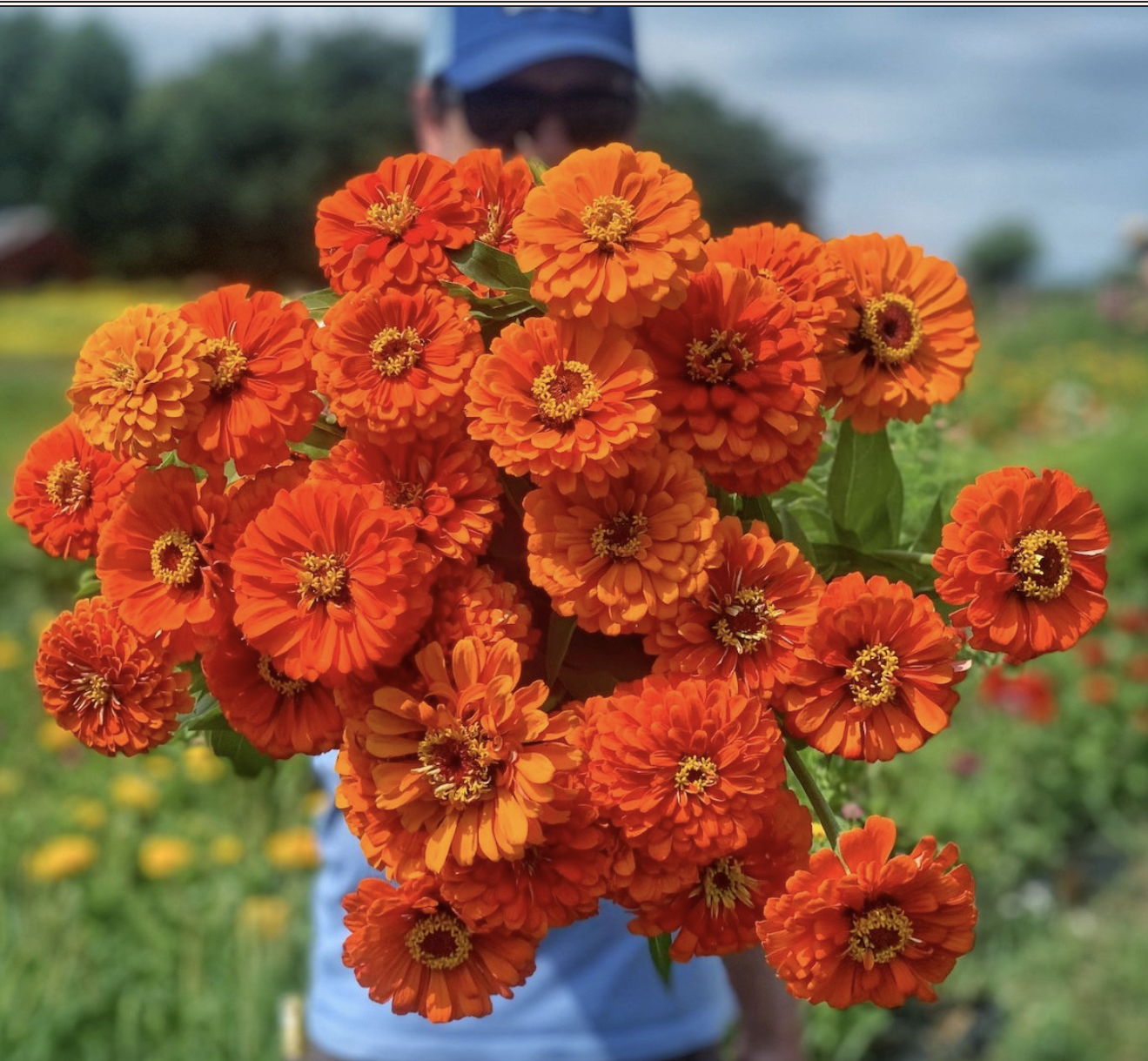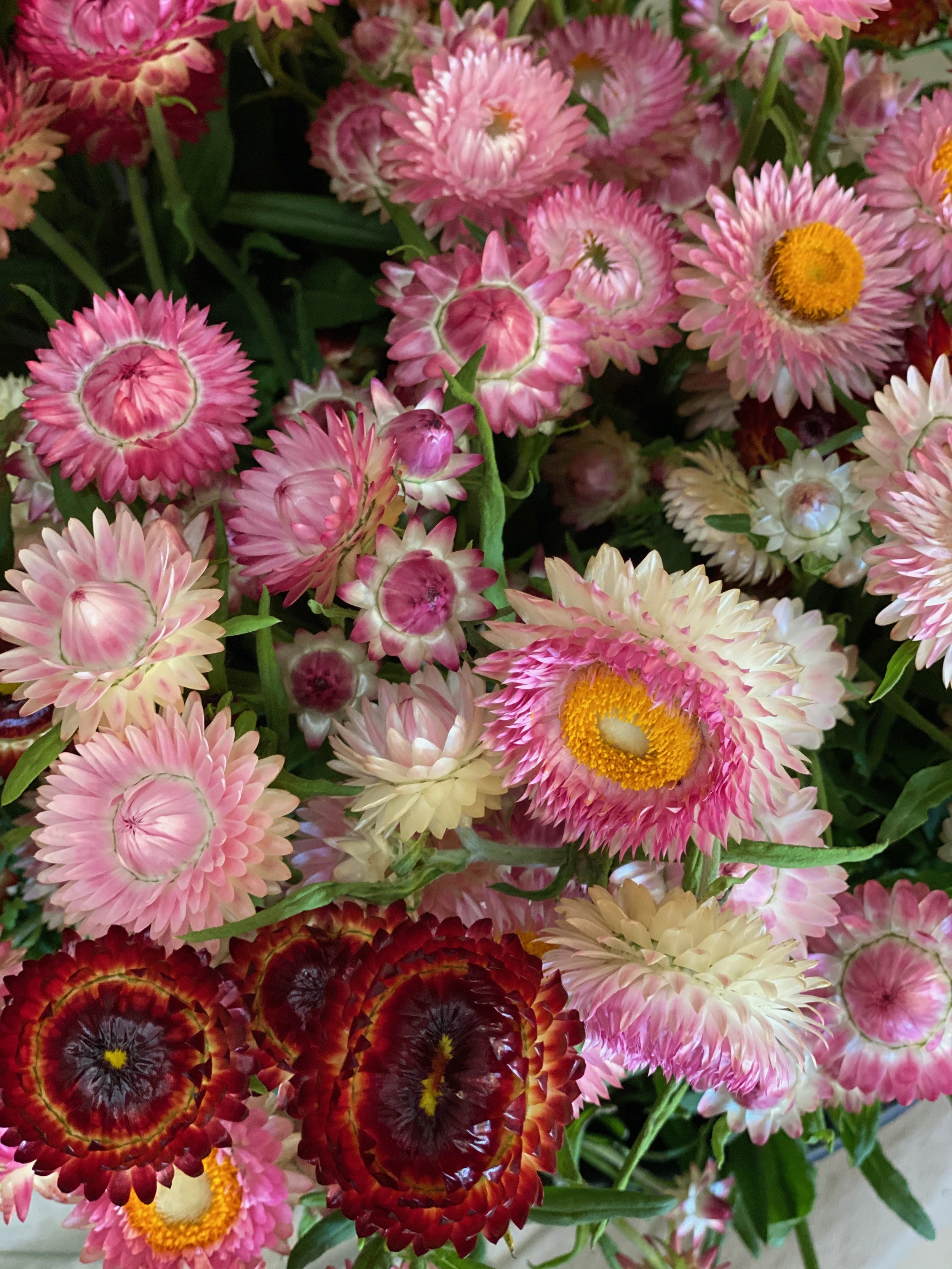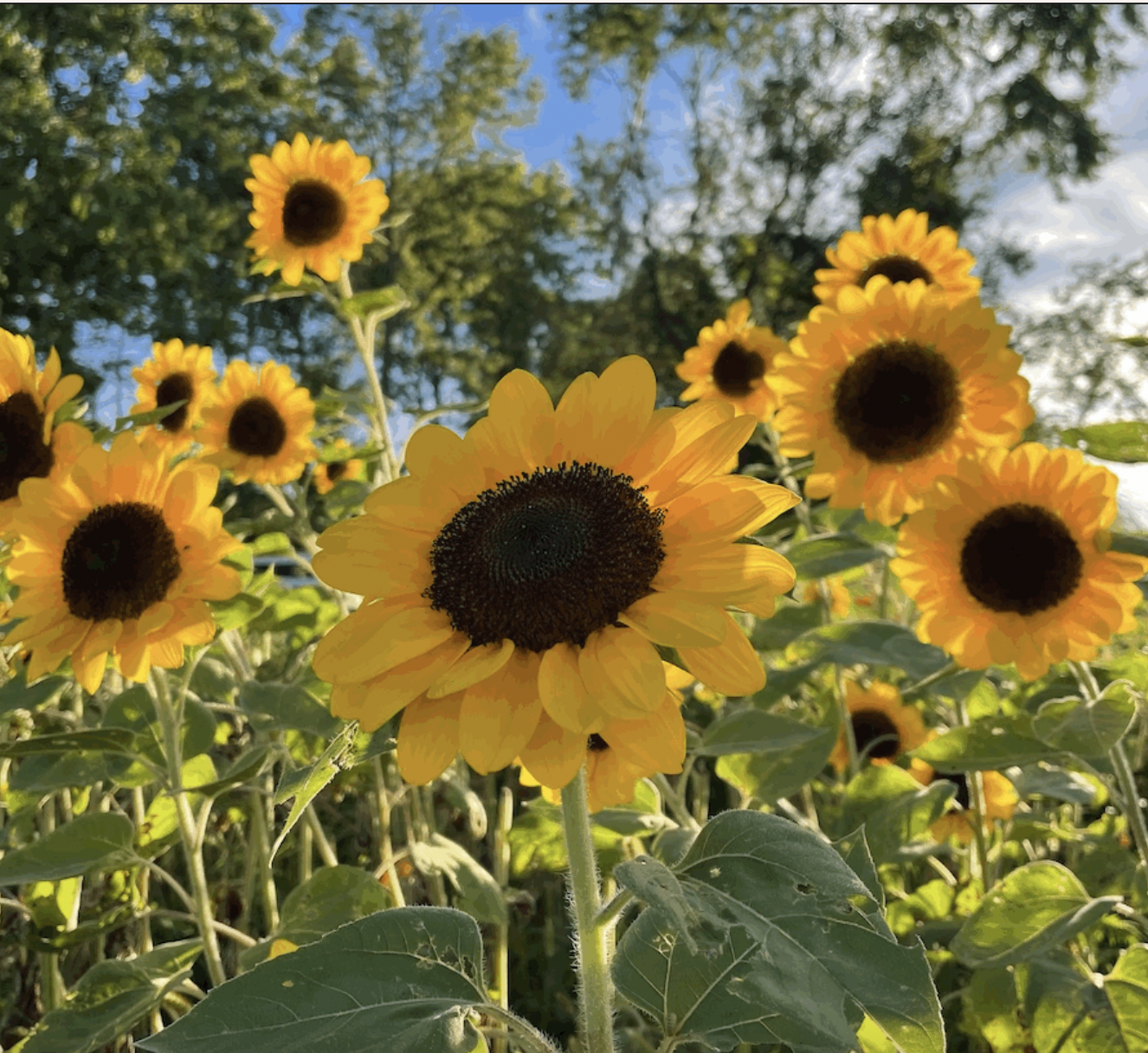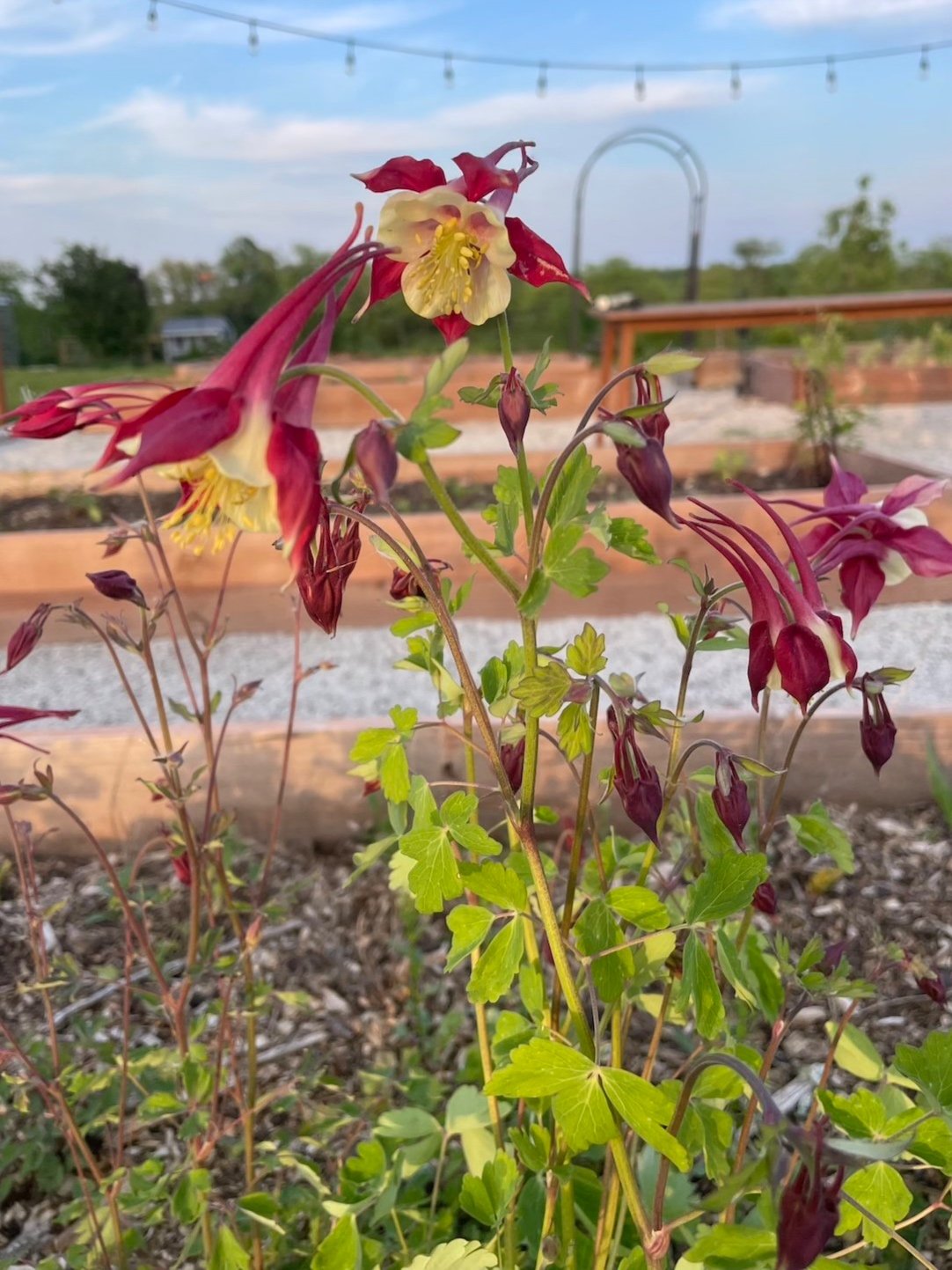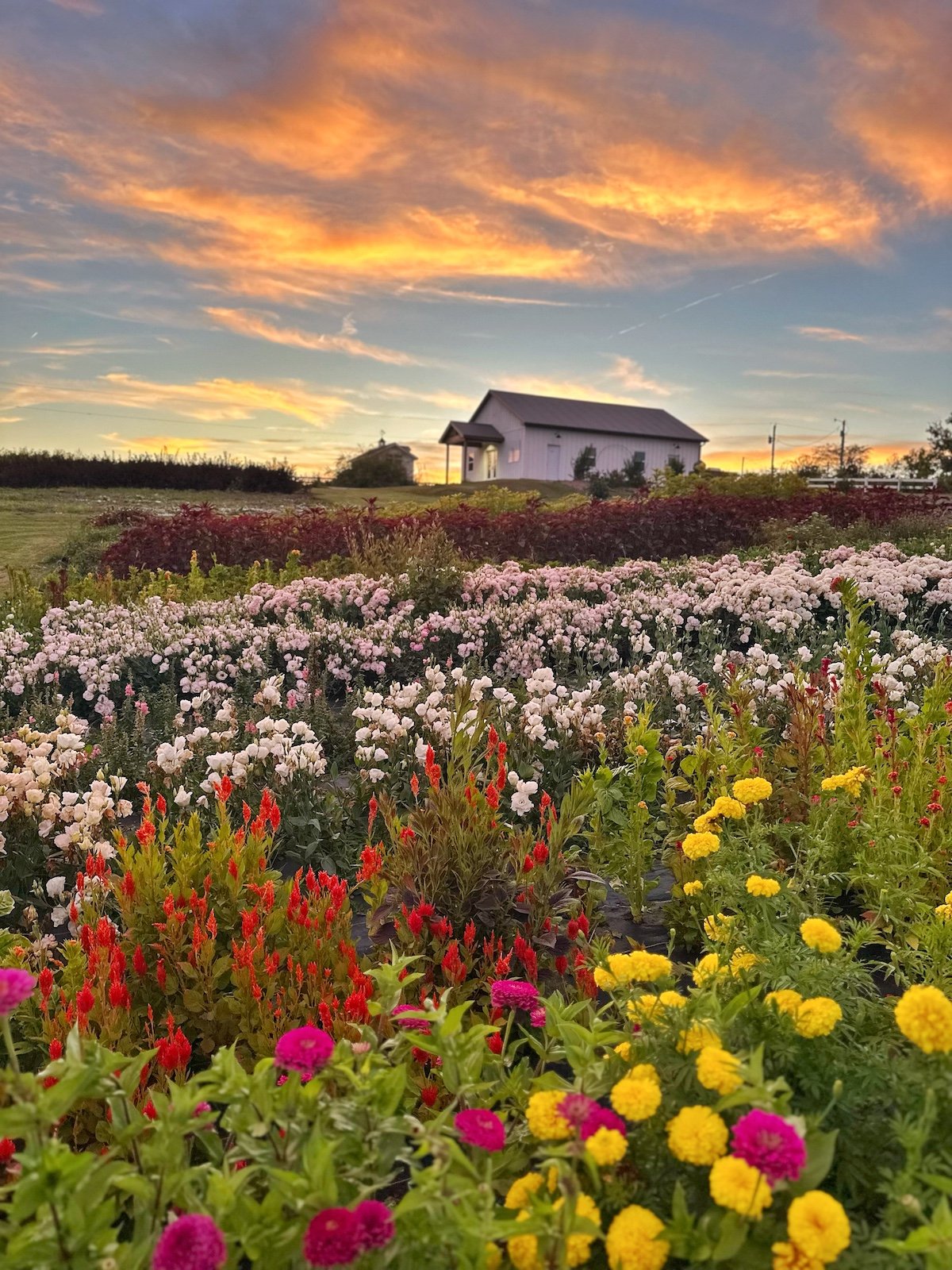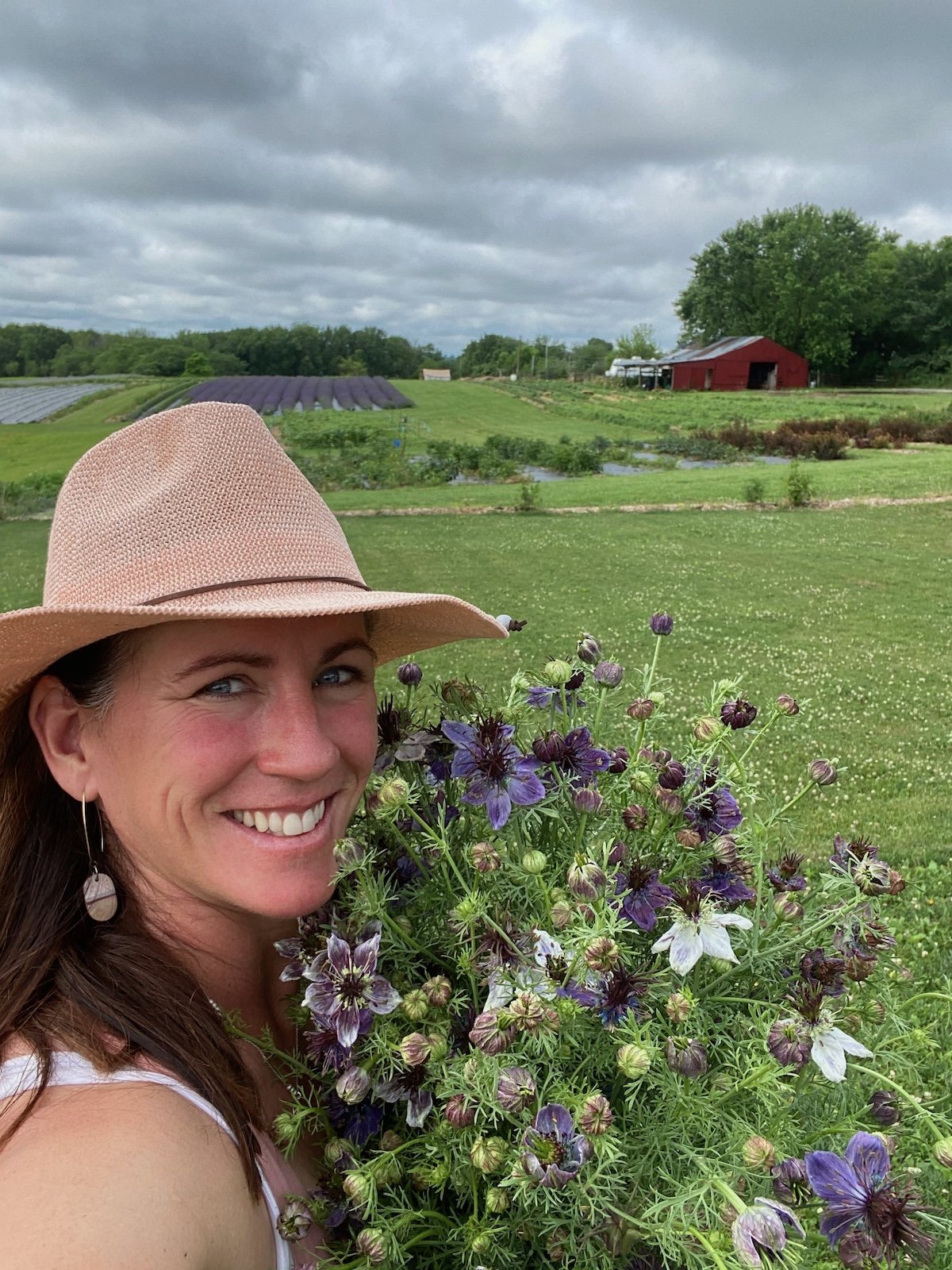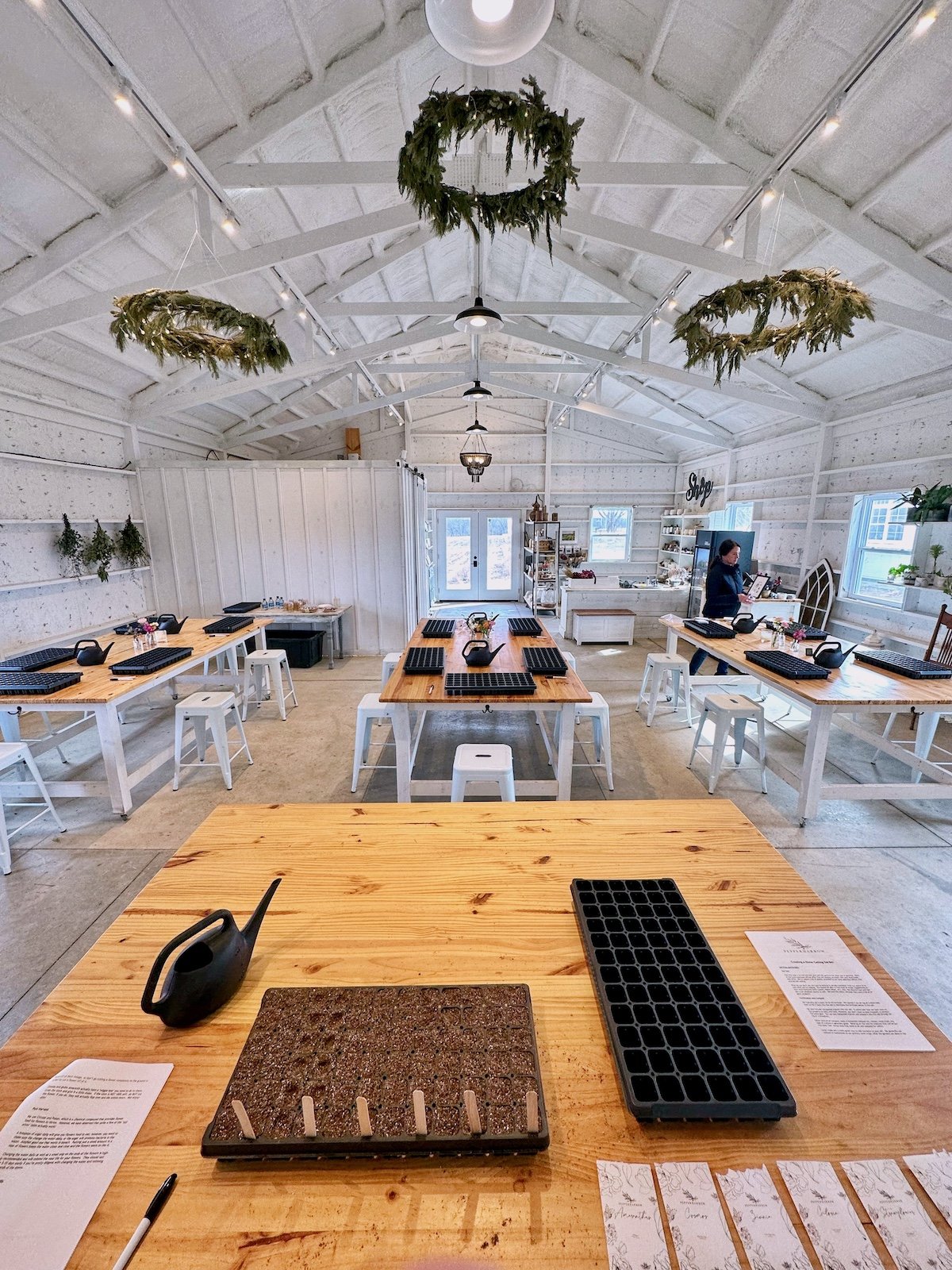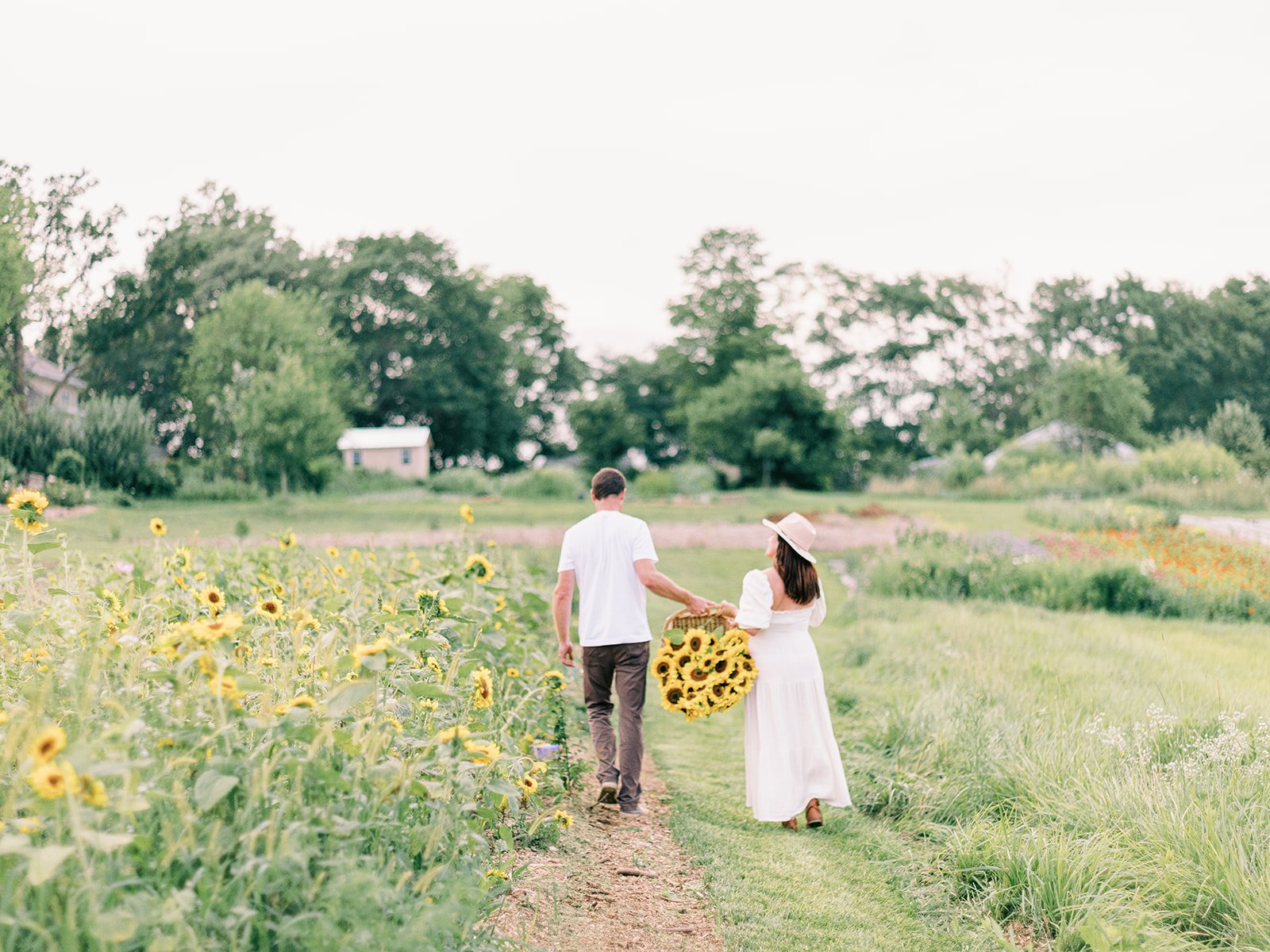
Easiest Flowers to Plant to Start a Cutting Garden
Looking to start your own cutting garden? Discover the easiest flowers to grow and enjoy all season long! From the vibrant hues of Celosia Chester Copperpot to the delicate beauty of Scabiosa Blue Cockade, we've curated a list of must-have blooms for your garden. Dive into our guide featuring Zinnia Benary's Giants, Strawflower, Sunflowers, and Salvia to create stunning bouquets or add a pop of color to your events. Start your cutting garden journey today and enjoy a bounty of beautiful blooms! Happy gardening!
Cutting gardens are a great way to grow a variety of flowers specifically for cutting and bringing indoors to enjoy. If you are considering starting a cutting garden, you may be wondering which flowers are the easiest to grow, most popular and reliable for the home garden.
Here are some of the most popular types of flowers for cutting gardens:
Celosia - Chester Copperpot
We’ve been working on Chester over the last 6 growing seasons, perfecting the color and texture. Colors in this mix range from coppery orange, soft gold, muted orange, to deep magenta red. This is the perfect celosia variety if you’re looking for more muted fall colors for your design work, or for fall bouquets. It’s an easy seed to get started and often likes to self seed from season to season, which is an added bonus!
2. Scabiosa
Scabiosa is a delicate, lovely flower that adds a soft, airy detail to a bouquet. We grow these beautiful flowers in succession, so we always have a few in bloom to make beautiful bouquets. We also love this flower, because it’s perfect to use for botanical dyeing. It makes a lovely periwinkle blue color as a botanical dye.
3. Zinnia Benary's Giant
Zinnias are a must have at our farm because of how tough and productive they are. They love the intolerable heat and humidity of a midwest summer. Once established, this flower just keeps giving blooms. Benary’s Giant provides a bloom large enough to work as a focal flower for our season bouquets. Oftentimes they help us through times when there aren’t any other focal flowers to pick from to use in bouquets, which makes them a nice bridge flower to use during seasonal
4. Strawflower
Strawflower is gorgeous in bouquets any time of year. The fun straw-like texture of the blooms is a fun tactile experience. Strawflower adds airiness into mixed bouquets, or for design work for weddings and other events. It’s also great as a dried flower to be used for various crafts. This is a must-have addition to the cut flower garden.
5. Sunflower
Sunflowers forever! There’s something so cheerful about sunflowers in a bouquet. They’ve been a true customer favorite for several years, whether they’re bunched into a bouquet by themselves, or added to mixed bouquets. Vincent’s Choice & Vincent’s Fresh is a favorite for later season bouquets, typically after July 1st.
By choosing a variety of these popular flowers, you can create a cutting garden that will provide you with a beautiful and abundant supply of flowers to enjoy all season long. Happy gardening!
In this video, we go over the easiest cut flowers to start your flower farm or even just get started growing flowers in your garden. Starting a flower farm can sometimes feel overwhelming. We hope these videos help you simplify the process into bite-size chunks. Learn about the top easy-to-grow cut flowers, such as marigolds, celosia, zinnias, cosmos, basil, etc. Get our advice, and use these stunning blossoms to enrich your arrangements.
Attracting Hummingbirds to Your Garden
Hummingbirds are a delight for gardeners, but not all flowers attract them equally. Opting for nectar-rich blooms like bee balm, cardinal flower, columbine, and foxglove is key. Bright colors, particularly red, orange, and pink, catch their attention best. Choose flowers with extended bloom times such as salvia and black-eyed susans, and vary flower sizes and shapes. Planting in sunny spots enhances their appeal. Consider a mix of bee balm, trumpet vine, zinnia, and others to create a vibrant hummingbird haven. With these tips, your garden can become a haven for these fascinating birds. Happy gardening!
Hummingbirds are beloved by many gardeners, and attracting them to your garden to watch them enjoy your flower blooms is absolutely wonderful. However, not all flowers are as attractive to hummingbirds, so it's important to choose the right varieties. Here are some great tips for selecting the best flower varieties and a few other tips and tricks for attracting hummingbirds to your garden.
Nectar Rich Flowers
The first suggestion is pretty straight forward, but maybe not something people think about as much when selecting flower varieties. We recommend choosing flowers that produce a lot of nectar. Hummingbirds are attracted to flowers that produce nectar, as this is their primary source of food. Some good flower varieties we suggest are bee balm, cardinal flower, columbine, and foxglove.
Bright and Bold!
Also consider the color of the flowers you’re choosing. Hummingbirds are attracted to brightly colored flowers, especially red, orange, and pink. These colors stand out to hummingbirds and are easily visible from a distance.
Long Bloom Time
Hummingbirds are attracted to flowers that produce a consistent supply of nectar, so it's helpful to choose varieties that bloom for a long period of time. Flowers that we suggest for long bloom time include salvia, coneflower, and black eyed susans.
Shape Diversity & Sunny Location
Plant a variety of flower sizes and shapes. Hummingbirds are attracted to different types of flowers, so it's helpful to plant a variety of sizes and shapes to appeal to a wider range of hummingbirds.
Also, grow your flowers in a sunny location. Hummingbirds are more likely to visit flowers that are located in a sunny location, as they prefer to feed in the warmth of the sun.
Best Flowers to Attract Hummingbirds
Here’s a list of some of the best flowers we grow that attract hummingbirds to the garden:
Bee Balm
Cardinal Flower
Columbine
Foxglove
Black Eyed Susan
Trumpet Vine
Zinnia
Salvia
Petunia
Penstemon
Agastache
Mexican Sage
Nicotiana
This list of flowers are ones that are not only beautiful, but they also produce lots of nectar, which is the primary source of food for hummingbirds. All of them also have a range of bright, vibrant colors, such as red, orange, and pink, which are especially attractive to hummingbirds. Planting a variety of these flowers in a sunny location will help to attract hummingbirds to your garden to enjoy these amazing birds.
We hope you learned a few tips you may not have known before about attracting hummingbirds to your garden. By following some of these tips, you’ll pick the best flower varieties for attracting hummingbirds to your garden to enjoy the beauty and charm of these amazing little birds.
Happy gardening!
XX Jenn and Adam
Valentine’s Day Flowers
Valentine’s Day at PepperHarrow was a busy day of pre-order, custom bouquet deliveries, along with a stunning, multi-bouquet delivery to our friends at Des Moines Mercantile.
For Valentine's Day, PepperHarrow headed out for a small adventure, spreading and sharing love through beautiful bouquets and custom pre-order centerpieces throughout Central Iowa. With these beautiful flowers in hand, we spent the day delivering gorgeous bouquets to local shops for them to sell and personal deliveries that were pre-ordered specially for the recipient. We loved spreading joy this Valentine’s Day and we were filled us to the brim with love for our loyal customers. Thank you to all who supported us!
We started the day with a special delivery to Des Moines Mercantile, where we adorned the space with stunning bouquets that captured the essence of love. Each arrangement was hand arranged and wrapped to perfection in pretty tissue paper and paper wrapping. After we dropped them off, it turned the the store into a burst of blooms with an incredible fragrance!
Next, we delivered our custom pre-ordered arrangements to places within a 30-mile radius of Des Moines. This personalized service allowed our customers to gift beautiful floral centerpieces to the special people in their lives. Included was a pretty Valetine’s Day card, which included heartfelt sentiments of the sender. From pink roses to wisps of fragrant stock, the bouquets were romantic, sweet and conveyed love and appreciation to those who received one. Gosh they were sweet!
W'e’re so grateful for the opportunity to have shared in the joy and celebration of love with our vibrant bouquets throughout our community. It was pretty special to be able to share a small part in tokens of appreciation and love. Thank you for making this Valentine's Day truly special with PepperHarrow!
XO,
Adam and Jenn
Jenn shows step by step how to make a simple flower centerpiece.
Jump Start Your Garden with Early Spring Flowers
As winter's chill begins to fade, anticipation for spring blooms grows among gardeners. To get a head start on the season and satisfy your green thumb cravings, consider planting cold-tolerant early spring flowers like snapdragons, stock, larkspur, and bupleurum. Starting these beauties in February ensures blooms from late April to mid-June, perfect for vibrant bouquets and garden displays.
Utilizing heated propagation houses and unheated hoop houses, we kickstart our flower seeds to ensure optimal growth. Our favorites include snapdragons for their playful blooms, fragrant stock varieties, and the delicate spikes of larkspur in shades of blue, pink, and white. Don't overlook the subtle elegance of bupleurum or the whimsical charm of Nigella, also known as love-in-a-mist.
For an extra early start, consider starting ranunculus indoors. These rose-like flowers add a stunning burst of color to late spring gardens. And don't forget about the versatile options like Agrostemma, Ammi, and Forget-Me-Not, which offer a diverse range of colors and textures.
With careful attention and proper care, you'll be rewarded with a flourishing garden and an abundance of blooms as the days grow warmer. Stay tuned for more tips and tricks to make your garden thrive!
As winter’s grip stars to slip away, the first little spurts of warm weather tease, the grass shows signs of greening, and gardeners begin to anticipate the start of spring and flowers to come. A great way to get a head start on the season and to fulfill the need for growing a little something is to plant a variety of early blooming flowers that can withstand a bit of the lingering chill. In this blog post, we'll go over a handful of our tried and true early spring flowers – snapdragons, stock, larkspur, and bupleurum – all of which can be started very early. We’ll also provide a few tips on kickstarting ranunculus and planting them before the last frost, so you can have all of these beauties blooming at the same time for bouquets!
Growing flowers in zone 5b, our last frost date is usually around mid May. To jump start our growing season, we start early spring flowers in February to be able to have flowers blooming by late April clear through to mid June. This is a great way to have flowers blooming super early!
All of the seeds we start in February are allowed to grown in a heated propagation house, then we harden them off and plant out into the ground around any time between mid to the end of March. Most of the little seedlings to in a covered hoop house, but many of them will be planted directly into the ground. For those seedlings, planted in the ground, you have to make sure that if the temperatures drop below 25° F that they are covered with a frost cloth temporarily. During the warmer day temperatures, this will need to be removed.
Today, we’re sharing a great list of seeds we’re starting right now to have flowers as early as possible for spring bouquets.
Seeds We’re Starting Now
Agrostemma
Also called Corn Cockle (a terrible name) is a gorgeous early spring flower that adds a decicate airy touch to spring bouquets.
Stock: Stock, with its fragrant, densely packed flowers, is another cold-loving flower that can be started early. These flowers are not only cold-tolerant but also make delightful additions to cut flower arrangements. Pro-tip: these seeds like exposure to the light, so they need the seeds need to be sown closer to the top of the seed starting mix. We grow both the Katz and Iron series.
Larkspur: Larkspur, with its tall spikes of delicate blooms, is a charming addition to early spring gardens. Larkspur thrives in cooler temperatures and can endure light frosts, gracing your garden with shades of blue, pink, and white. With larkspur, we sow some directly out into the garden, and we also seed start some in trays to be planted out. Both ways work! For more seed starting directions for this flowers, check out our YouTube video.
Snapdragons
Snapdragons are well known for their fun, snap-like blooms that add a playful and beautiful touch to the garden. Our favorite varieties are any of the Costa series, which can be found on Johnny’s website. We also love Potomac Appleblossum, Maryland shell pink, and absolutely any Madame Butterfly series in the spring. They’re so delicate and perfect for early spring bouquets!
Snapdragons benefit from a very consistent, controlled environment. Because our prop house isn’t air tight, it means that the snapdragons will not thrive and will not germinate like we need them to. That was a learning lesson from last year. It was the first time that we’d grown in the propagation house here, and we saw that they needed a little bit more controlled environment, and they need a warmer environment. The warmer, the better for snapdragons.
Nigella
Nigella is also known as love-in-a-mist, is a delicate flower with intricate pastel blooms, perfect for spring bouquets. Its unique foliage and symbolism of love make it versatile and whimsical in various bouquet styles. Whether you use the bloom itself or the cool pod it makes after it blooms, either way is incredible and so fun!
Bupleurum: Bupleurum, an often-overlooked gem, boasts delicate greenish-yellow flowers and adds a unique texture to floral arrangements. This cold-tolerant plant is not only a fantastic filler in bouquets but also offers an airy elegance to your garden beds. This is another one that we included our seed starting tips and tricks for on YouTube. It’s a trickier seed to get started, so be sure to check it out.
Ranunculus: While ranunculus is not as cold-tolerant as some other early spring flowers, they can still be started indoors to get a head start on the growing season. Plant ranunculus tubers in pots or trays about 8-10 weeks before the last frost. Once the threat of frost has passed, transplant them into well-drained soil with plenty of sunlight. These vibrant, rose-like flowers will reward you with a stunning display of color in late spring.
Other GREAT Flowers Perfect for Starting Early Spring:
Ammi
Forget-Me-Not
Dara
Orlaya
Saponaria
We hope this have given y’all some inspiration of some flowers you can start in early spring to have flowers earlier in the season. All of the flowers we mentioned here provide a gorgeous array of color and texture in the garden and for bouquets. By starting these flowers early, providing them with the care they need, you'll be rewarded with a vibrant and flourishing garden and flowers for cutting, as the days grow longer and warmer.
XX Jenn and Adam
Seed Starting Basics
Embarking on the journey of gardening or flower farming unveils a world of possibilities, but for enthusiasts seeking precision and a bountiful harvest, seed starting emerges as an essential chapter in their horticultural adventure. This practice not only aligns with the rhythm of nature but also empowers cultivators with a meticulous approach to plant propagation.
The art of seed starting unfolds within the confines of indoor spaces or carefully curated environments like greenhouses, where the germination process is ushered into existence. No longer does one have to cast seeds into the open expanse of the garden, crossing fingers in hopes of sprouts. Instead, by commencing the journey indoors, gardeners seize command over the initial phases of a plant's life cycle, orchestrating a symphony of growth with calculated precision.
The beauty of starting seeds indoors lies not only in the hands-on involvement it necessitates but also in the certainty it bestows upon cultivators. Gone are the days of uncertainty, where the whims of nature dictated the fate of scattered seeds. Instead, by germinating and nurturing young plants in controlled environments, individuals gain a profound understanding of their impending floral abundance.
The allure of knowing exactly how many plants will grace the garden creates a sense of order amidst the chaotic beauty of nature. Seed starting transforms gardening into a strategic venture, offering a tangible and quantifiable measure of the impending botanical splendor. Beyond the meticulous counting of plants, there's an additional advantage that beckons enthusiasts – a head start on the growing season.
By initiating the seed starting process early, indoors, cultivators gain a temporal advantage that transcends the conventional boundaries of the growing season. This temporal leap propels them ahead, enabling an extension of the cultivation period and the promise of blooming flowers earlier in the seasonal ballet. As the world awakens to the warmth of spring, these preened seedlings, nurtured with care and intentionality, stand as a testament to the ingenuity of those who dared to cultivate the future amidst the embrace of their indoor sanctuaries.
Seed starting is a necessary part of gardening and flower farming that offers tons of advantages for flower lovers. By starting the germination process indoors or in a controlled environment, such as a greenhouse, you can gain control over the early stages of a plant's life cycle. Think: no more throwing seeds out into the garden, seeing if they will sprout. Starting seeds indoors and growing them up before planting them out is helpful, because you know exactly how many plants you’re going to have. Also, doing seed starting early, indoors, can give you a huge head start on the growing season! This helps to extend the cultivation period to have blooms earlier in the growing season.
Starting Plants from Seeds:
Starting plants from seed fosters a deeper understanding of plant biology and horticulture, because you get to witness the complete life cycle from germination to maturity of your plants. It almost feels like magic! Additionally, starting from seeds gives you access to a larger amount of plant varieties, including heirlooms and a few unique selections not commonly found as established plants at nurseries. Ultimately, starting plants from seeds gives flower growers more flexibility, knowledge, and a sense of connection to the plants they’re cultivating.
Where to Begin with Seed Starting
Selecting the Right Seeds:
Choose Varieties Suitable for Your Region and Climate:
Consider local climate conditions and conditions in your own growing space such as temperature, sunlight, and humidity.
Research plant hardiness zones to match varieties that can grow in your region.
Check seed packets for information on ideal growing conditions.
Essential Tools and Supplies:
Seed Trays, Pots, and Containers:
Choose containers with drainage holes to prevent seedlings from getting waterlogged.
Use trays for easy organization and transportation of seedlings.
For home gardeners, opt for biodegradable pots that can be planted directly into the soil to minimize transplant shock. For larger scale flower farming, uses a butter knife to pry the seedling out of the seed staring cell tray.
Quality Seed Starting Mix:
Select a sterile and well-draining seed starting mix to prevent diseases and provide proper aeration.
Look for mixes with a balanced blend of peat moss, vermiculite, and perlite.
Avoid using regular garden soil, as it can be too heavy and may harbor pathogens.
Proper Lighting and Temperature Requirements:
Provide adequate light with fluorescent or LED grow lights if natural sunlight is insufficient.
Monitor and maintain consistent temperatures for germination, typically between 70-80°F (21-27°C).
Adjust lighting height and duration as seedlings grow to prevent leggy growth.
Indoor Seed Starting:
Creating a Dedicated Seed Starting Area:
Designate a well-lit and warm area for indoor seed starting, such as a windowsill, greenhouse, or under grow lights.
Consider using a waterproof tray to contain any water spills and keep the area tidy.
Timing and Scheduling for Successful Germination:
Calculate the ideal germination time by working backward from your region's last expected frost date.
Consult seed packets for specific germination timelines and instructions.
Use a seed starting calendar to plan when to sow seeds based on the desired transplant date.
Outdoor Seed Starting:
Direct Sowing in the Garden:
Choose plants that are well-suited for direct sowing, such as sunflowers, cosmos, zinnias, etc.
Prepare the garden bed by clearing debris and loosening the soil.
Follow seed packet instructions for planting depth and spacing, and water the area regularly until seeds germinate.
Soil Preparation & Care:
Nutrient Availability: Ensure the soil is rich in essential nutrients, as seedlings rely on these nutrients during early growth.
Texture and Aeration: Choose a well-draining seed starting mix with a fine texture to promote root development and prevent waterlogging.
pH Level: Check and adjust the pH level of the soil to create an optimal environment for seed germination and seedling growth.
Watering & Humidity Control:
Water gently to avoid displacing seeds or compacting the soil.
Keep the soil consistently moist, but not waterlogged, to support germination and early growth.
Use a watering can with a fine nozzle for precision
Maintain a consistent humidity level in the seed starting area, especially for indoor germination.
Use a humidity dome or cover trays with plastic wrap to create a greenhouse effect.
Ventilate the area regularly to prevent fungal issues and promote healthy air circulation.
Identify When Your Seedlings Are Ready to be Transplanted Outside:
True Leaves Stage: Seedlings are typically ready for transplanting when they have developed their first fours sets of leaves.
Root Development: Check for a well-established root system by gently removing a seedling from its container to inspect root growth.
The Bigger the Better: Even though little seedlings are okay to be transplanted outdoors, the bigger you can grow your little seedlings before you transplant outdoors, the better.
Before Transplanting, Get Your Seedlings Ready Via the Hardening Off Process
What is the Hardening Off Process? It’s the gradual exposure to outside growing conditions. The plants will literally start out tender and with exposure to outside elements, will begin to feel stiff to the touch.
Start Slowly: Gradually introduce seedlings to outdoor conditions by placing them in a sheltered (protected from too much wind), shaded area for short periods. Example: Day 1 = 1 hour; Day 2 = 2 hours, etc.
Increase Exposure Time: Slowly extend the time seedlings spend outdoors over the course of 1-2 weeks.
Adjust Light Levels: Gradually expose seedlings to direct sunlight, starting with filtered light and progressing to full sun exposure.
Importance of Acclimating Seedlings Before Transplanting:
Prevents Transplant Shock: Hardening off helps seedlings acclimate to the differences in temperature, light, and wind between indoor and outdoor environments, reducing the risk of transplant shock.
Promotes Stronger Growth: Seedlings that undergo a hardening-off process tend to develop stronger stems and roots, enhancing their ability to withstand outdoor conditions.
Minimizes Stress: Acclimating seedlings gradually minimizes stress, allowing them to adjust to the new environment without compromising their health and vigor.
After your little seedlings have been transplanted outside, water them at least every other day, especially if it’s hot outside, but allow for the ground to dry out in between. Watering plant babies well in the beginning helps to get them established. Once established, they do not require a ton of watering unless there are draught conditions that affect the plant.
We hope you learned some basic seed starting tips and tricks! Starting seeds ahead of the growing season is a great way to get a jump on starting flowers before the last frost date. This way, you can enjoy beautiful bouquets earlier in the season. If you’re looking for a great place to grab seeds to start your garden this year, check out our seeds that go online February 10th at Noon. Most of the varieties we grow here on the farm will be available in our seed shop. Grow a little piece of PepperHarrow in your garden!
XX Jenn and Adam




